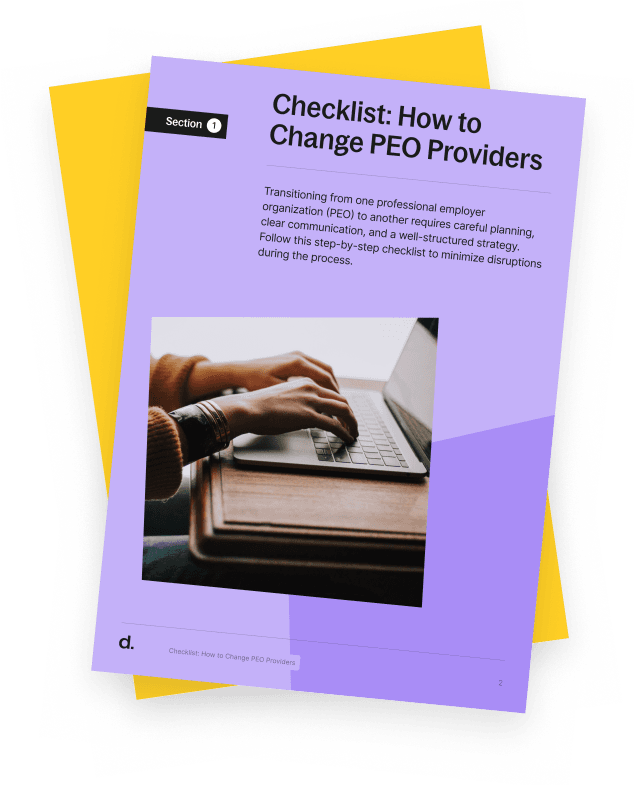Article
10 min read
PEO in New York: Payroll, HR and Compliance Guide for US and Global Employers
PEO

Author
Shannon Ongaro
Last Update
July 17, 2025

Table of Contents
What is a PEO in New York?
New York PEO licensing and required onboarding forms
Benefits of using a New York PEO
PEO vs EOR vs opening a New York entity
Key New York payroll, labor, and employment laws
How to choose the right PEO in New York
Manage New York, US, and global workers with Deel
Key takeaways
-
A New York‑registered PEO lets employers of any size outsource payroll, HR, benefits, and state/local compliance so they can focus on growth.
-
Choosing PEO vs EOR vs opening your own NY entity hinges on whether you have a US entity, how fast you need to hire, and how much compliance you can manage in‑house.
-
Deel’s in‑house PEO, integrated with global EOR coverage and real‑time Compliance Hub alerts, helps domestic and international companies scale compliantly across New York and beyond.
Working with a PEO in New York lets employers of any size, including domestic US companies and international teams entering the US market, outsource payroll, HR, and state compliance under a licensed co-employment model. A New York-registered PEO helps manage wage and hour rules, required insurance, benefits, and reporting so you stay compliant.
But which model is right—PEO, employer of record (EOR), or opening your own New York entity? Below you’ll find licensing rules, required onboarding forms, key New York labor/payroll laws, comparison guidance, and a step-by-step process to choose the best path.
What is a PEO in New York?
A professional employer organization (PEO) enters a co-employment relationship with your company: the PEO handles many employer administration tasks—payroll processing, tax filings, benefits administration, required notices, and some HR compliance—while you retain day-to-day control over work, culture, and performance.
In New York, PEOs must register with (and renew through) the New York State Department of Labor (NY DOL) to operate legally.
Why it matters: New York maintains some of the most employee-protective wage, leave, and anti-discrimination laws in the US. Partnering with a licensed PEO can help you interpret overlapping state, city, and federal rules and keep filings current.
Good to know: A PEO relationship does not replace the need for a US legal entity—you must already have (or form) one. If you need to hire in New York before you stand up an entity, consider an employer of record (EOR) instead.
New York PEO licensing and required onboarding forms
New York regulates PEOs under the New York Professional Employer Act. Providers must register (or obtain an exemption) with the NY DOL and renew annually. Before signing, confirm a provider’s active status in the NY DOL PEO database and request copies of its current workers’ compensation, disability insurance, and other required coverages.
Quick license check steps
-
Search the NY DOL PEO provider list and confirm active/renewal date.
-
Request certificate(s) of insurance (workers’ comp, disability, unemployment).
-
Review financial responsibility and bonding requirements.
-
Ask how employee data, payroll taxes, and required notices are delivered/archived.
Mandatory onboarding and compliance forms (federal + New York / NYC)
Requirements vary by industry, work location (NYC vs rest of state), and headcount. Consult counsel.
| Form / Notice | What it does | Who issues / When |
|---|---|---|
| IRS Form W-4 | Employee federal income tax withholding elections | Employee to employer at hire / when status changes |
| USCIS Form I-9 | Verifies identity and work authorization in US | Employer within 3 business days of start |
| NY State Tax Withholding Form IT-2104 | NY state withholding allowances / residency | Employee at hire; update on life changes |
| PEO Arbitration Agreement | Directs certain employment disputes to arbitration | PEO; may allow opt-out—request details |
| Employee Communications Consent | Authorizes digital notices / e-delivery | PEO or employer at hire |
| Worksite Employee (WSE) Notice of PEO Relationship | Discloses co-employment roles and contacts | PEO at hire + when provider changes |
| NY Electronic Monitoring Notice | Alerts employees that email/phone/network use may be monitored | Employer at hire (state law) |
| NY Employer Information Privacy Notice | Limits public display of personal employee data | Employer / PEO onboarding |
| NY Pay Rate Form | Employee acknowledgment of rate, pay day, allowances | Employer at hire; keep signed copy |
| NYC Earned Safe and Sick Time Notice | Explains local paid safe and sick leave rights | Employer if worksite in NYC |
| NY Pregnancy Accommodations Notice | Reasonable accommodation rights | Employer statewide |
| NY Sexual Harassment Prevention Notice | Anti-harassment rights + mandatory training | Employer statewide; annual training |
| NYC Stop Sexual Harassment Factsheet | Additional NYC protections and complaint channels | Employer if worksite in NYC |

Benefits of using a New York PEO
Partnering with a PEO helps employers optimize HR/payroll operations, secure competitive benefits, and control compliance risk across New York’s complex regulatory landscape.
Efficiency and focus
Outsource payroll runs, tax filings, new-hire reporting, and benefits administration so internal teams can focus on growth, FP&A, and talent strategy. Many PEO platforms automate deadline tracking (rate changes, leave accruals, contribution limits) and reduce manual errors.
On-demand New York expertise
State and local rules shift frequently. A PEO gives you access to HR, payroll, and compliance specialists who monitor NY DOL updates, city ordinances, new posting requirements, and required employee notices without adding full-time headcount.
Better benefits and buying power
Because PEOs pool employees across many client companies, they can often negotiate more competitive rates on health insurance, retirement plans, workers’ compensation, and ancillary benefits than most stand-alone employers could secure, which is especially valuable in high-cost New York labor markets.
See also: How to Choose the Best PEO for Health Insurance
Compliance and risk reduction
Labor violations in New York can trigger steep penalties, litigation, and reputational damage. Licensed PEOs track wage and hour, safe/sick leave, pay transparency, anti-harassment, and new laws (like the state’s Captive Audience restrictions) and surface alerts before issues escalate.
Data visibility and decision support
Modern PEO dashboards centralize payroll costs, benefit elections, contribution rates, and compliance tasks in one system, supporting workforce planning across multiple New York (and multi-state) locations.
PEO vs EOR vs opening a New York entity
Not sure which route fits your hiring plan? Use the comparison below and read more in our guide to EOR vs PEO.
| Criteria | PEO (Co-employment) | Employer of Record (EOR) | Open NY Entity (DIY) |
|---|---|---|---|
| US entity required? | Yes. You operate (or form) a US entity; PEO supports HR/payroll. | No. EOR is legal employer where you lack an entity. | Yes. You register/incorporate directly in NY and handle all employer obligations. |
| Speed to hire | Moderate (contract + carrier setup, then onboard). | Fast in supported jurisdictions; hire without entity. | Slowest—entity formation, tax accounts, payroll setup. |
| Who files payroll taxes | Your entity FEIN (PEO files/assists). | EOR’s FEIN; EOR remits taxes. | Your entity; 100% your responsibility. |
| Benefits buying power | Aggregated across PEO pool; group rates. | Depends on EOR plans; good for rapid start. | You negotiate carrier-by-carrier; scale matters. |
| Compliance coverage | Shared; PEO monitors federal/state/local laws. | EOR assumes in-country employer compliance. | All in-house (or outsourced advisors). |
| Best for | Employers active in US (multi-state) needing scalable HR/payroll and benefits. | Pre-entity hiring; testing markets; distributed or global teams. | Large, established headcount with internal HR/payroll infrastructure. |
Expansion tip: Many companies use a hybrid approach: PEO in states where they’ve formed entities (e.g., New York) and an EOR in new US states or international locations where they haven’t yet set up. Deel supports both.

Guide
Expanding your business in the US?
Key New York payroll, labor, and employment laws
Organizations may find it challenging to navigate and stay updated with New York’s intricate state laws. When you partner with a PEO, these become the provider’s responsibility. Here’s an overview of some of the New York-specific regulations that employers need to be aware of:
Payroll and benefit laws in New York
| Topic | Core NY Rule | Key Details / See Also |
|---|---|---|
| Minimum wage | Regional rates: $16.50 in NYC, Long Island, and Westchester; $15.50 elsewhere. | Use the official Lookup Tool before each rate change. See also: US minimum wage guide. |
| Pay frequency | Varies by worker class (manual, clerical, etc.); many must be paid at least semi‑monthly (some weekly). | Document pay schedule in onboarding docs. Also governs final pay timing. |
| Final paychecks | Departing employees must receive all remaining wages on the next regular payday. | Mail if requested; retain proof of delivery. |
| Tipping | Cash wage plus tips must meet or exceed applicable NY minimum; industry/region differentials apply. | Track pooled vs direct tips; check NY wage orders for current tipped cash wages. |
| Overtime | 1.5× regular rate for hours >40/week (FLSA + NY). | Confirm exempt status tests; audit misclassified salaried roles. See also: US overtime by state. |
| Paid sick leave | Tiered: 56 paid hrs (100+ emp); 40 paid hrs (5–99); ≤4 emp tiers depend on net income. | Accrues 1 hr / 30 hrs worked; carryover allowed. See also: US sick leave laws. |
| New York Paid Family Leave | Up to 12 weeks job‑protected, partial wage replacement; may run concurrent with the FMLA. | Coordinate benefits and payroll deductions. Consider: US parental leave. |
| Pay transparency | Employers with ≥4 employees must include salary ranges (and note if commission‑based) in job ads. | Applies to promotions and transfer opportunities; keep range audit trail. See also: US pay transparency. |
| Salary history ban | Employers cannot ask about or rely on prior compensation (applicants or current employees). | Do not request from other sources; scrub legacy forms. |

New York labor laws
| Topic | Core NY Rule | Key Details / See Also |
|---|---|---|
| Meal and rest breaks | Labor Law §162 requires meal periods by shift length and start time. | E.g., mid‑day meal for shifts ≥6 hrs spanning 11am–2pm; industry variations apply. |
| Whistleblower protections | Expanded LAB §740 protects workers from retaliation for reporting violations or dangers. | Mandatory workplace posting covers a broad range of disclosures. |
| Call‑in pay | Workers called in but not put to work may be due up to four hours (or scheduled shift) at minimum wage. | Check the wage order for industry‑specific variations. |
| Workplace health and safety | NY DOSH / PESH requirements supplement federal OSHA standards. | Multi‑layered compliance; see OSHA NY area offices. |
New York employment laws
| Topic | Core NY Rule | Key Details / See Also |
|---|---|---|
| Worker classification | To be a contractor, a worker must be free from supervision, direction, and control; default presumption = employee. | Misclassification can trigger UI, workers’ comp, tax, and wage liabilities. See penalties. |
| Separate business entity | Distinguishes bona fide businesses (e.g., sole proprietors/corporations meeting criteria) from employees. | Review 12‑factor tests before classifying outside payroll. |
| Unemployment insurance | Employers fund NY UI; rates are assigned annually. | Respond to claims; see SUI rates by state. |
| Recordkeeping and penalties | Keep employment, payroll, classification, and injury records ~4 yrs; violations can cost $1k–$50k+ per 10 days. | Criminal exposure is possible for willful misrepresentation. |
| Fair Chance Act (NYC) | Limits criminal history inquiries until conditional offer; detailed adverse action steps. | Applies to NYC worksites/employees; document individualized assessment. |
| Clean Slate Act | Seals many conviction records after waiting periods (effective Nov 2024; phased rollout). | Adjust background screening flows; check exceptions (e.g., sex offenses). |
| At‑will employment and terminations | NY is an at‑will state—termination is allowed for any non‑discriminatory reason, such as an absent contract. | Anti‑discrimination and retaliation laws still apply; document the cause. See state guide to at-will laws. |
Additional requirements and enforcement
The above information covers just some of the labor, payroll, and employment laws in New York. Where there’s an overlap between local, state, and federal laws, organizations must follow the ones that offer the most rights and protections to their workforce.
See also: US Payroll Tax Guide: New York
Deel PEO
How to choose the right PEO in New York
Use the steps below to score and compare providers, which is especially important if you manage headcount across multiple US states or are entering New York for the first time.
1. Clarify current and future HR needs
Audit internal workload, error rates, compliance exposure, and upcoming growth (new locations, headcount scaling, union environments). Map which tasks must move off internal teams.
2. Shortlist PEOs with New York expertise
Prioritize PEOs licensed in New York and request proof of active registration and certificates of insurance. Ask for case studies from companies like yours (industry, size, multi-state footprint).
3. Evaluate service range and benefits depth
Compare payroll accuracy tools, tax filing, benefits administration, HRIS integrations, reporting, and multi-state support. Clarify cost pass-through vs admin fees.
4. Assess compliance and risk management
How does the PEO monitor new laws (e.g., wage updates, pay transparency posting, sick leave accrual changes, Captive Audience restrictions)? Do they provide proactive alerts? Sample compliance reports? (Deel clients can leverage Deel Compliance Hub for real-time alerts.)
5. Check support quality and responsiveness
Review SLAs, dedicated account team model, after-hours support, language coverage, and escalation paths—critical for distributed or international teams operating in New York time zones.
6. Review pricing and contract terms
Understand admin fees (per-employee vs % payroll), benefit carrier pass-through costs, termination/transition clauses, and tax filing responsibilities under whose FEIN.
7. Plan implementation and change management
Align on onboarding timeline, data migration, employee communications, and first parallel payroll test. Good change management reduces payroll disruption and adoption friction.

Manage New York, US, and global workers with Deel
Deel’s in-house PEO is built to support fast-growing teams with the tools, coverage, and service they need, all in one platform.
- Fully in-house support Deel PEO is run entirely by internal specialists, including certified professionals, licensed advisors, and dedicated HRBPs. Clients get direct access to expert guidance across payroll, benefits, and compliance, with no third-party handoffs or delays.
- Benefits admin made easy Admins can choose, enroll, and manage health benefits for US employees directly in the Deel platform. They can view costs, track coverage, and handle renewals—all in one place, without chasing brokers or juggling paperwork.
- Exclusive access to Aetna International plans
For teams with globally mobile employees, Deel is the only PEO to offer Aetna International health plans, ensuring continuous coverage across borders without needing to manage separate providers. - All-in-one platform Admins can manage hiring, onboarding, payroll, and benefits in one place. Deel simplifies every step, from enrollment to renewals, reducing HR admin time.
- Compliance coverage at every level
Deel helps businesses meet federal, state, and local employment laws, taking the guesswork out of US HR compliance.
Explore how Deel’s in-house PEO can help you offer better benefits and stay compliant from day one.
Book a demo to learn more about using Deel’s PEO in New York.
See also:
Disclaimer: This article is for informational purposes only and is not legal advice. Always consult qualified counsel. Content accurate at time of publishing; laws and rates change frequently—verify before acting.
FAQs
Are PEOs required to be licensed in New York?
Yes. The New York Professional Employer Act requires PEOs to register (or obtain an exemption) with the NY Department of Labor and renew annually. Proof of financial responsibility and required insurance coverage (workers’ comp, disability) is part of the process.
Do I still need workers’ compensation if I use a PEO?
Coverage must exist for all employees. In co-employment, the PEO typically procures and administers workers’ comp policies, but confirm policy ownership, billing, and experience mods—New York’s Workers’ Compensation Board enforces strict penalties for non-coverage.
Is a PEO the same as an Employer of Record (EOR) in New York?
Not exactly. A PEO supports employers that already have a US entity (co-employment model). An EOR becomes the legal employer for workers in a jurisdiction where you don’t have an entity—useful for pre-entry hiring or rapid expansion.
How are PEO fees structured in New York?
Most providers charge a per-employee-per-month (PEPM) admin fee, a percentage of payroll, or tiered pricing by headcount. Evaluate what’s included—benefits administration, HR tech, compliance alerts—and whether insurance premiums are billed separately from admin fees.

About the author
Shannon Ongaro is a content marketing manager and trained journalist with over a decade of experience producing content that supports franchisees, small businesses, and global enterprises. Over the years, she’s covered topics such as payroll, HR tech, workplace culture, and more. At Deel, Shannon specializes in thought leadership and global payroll content.















